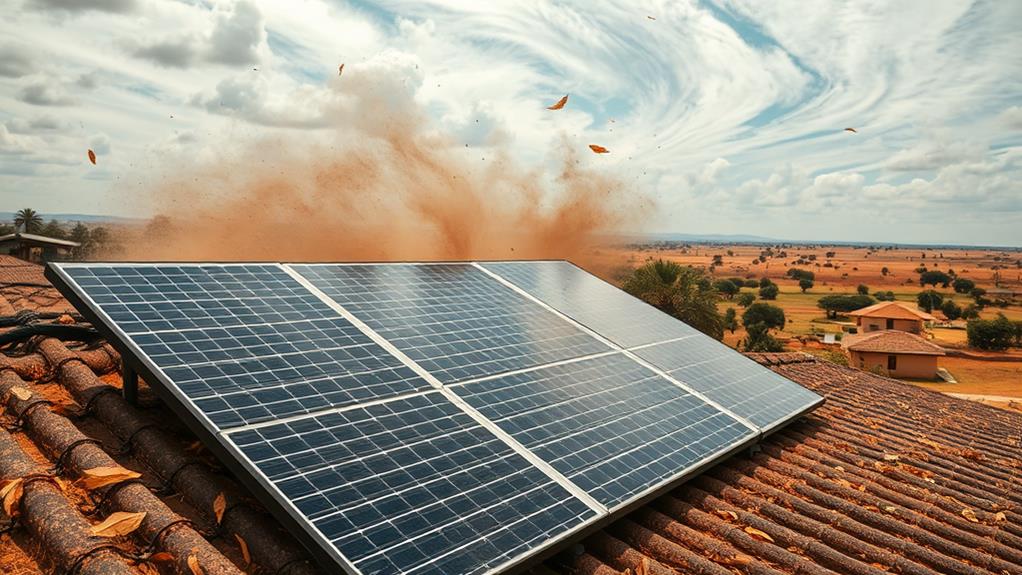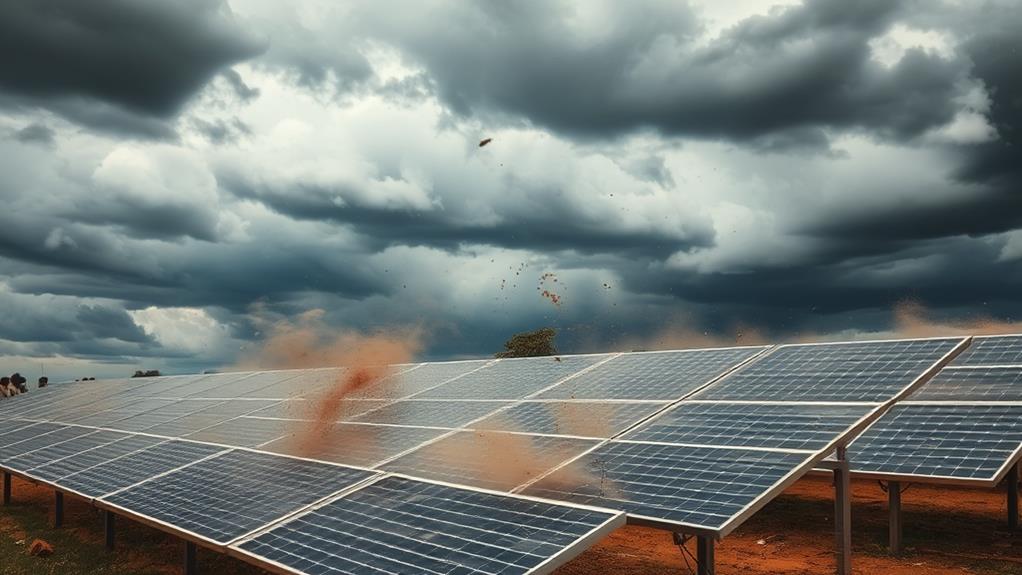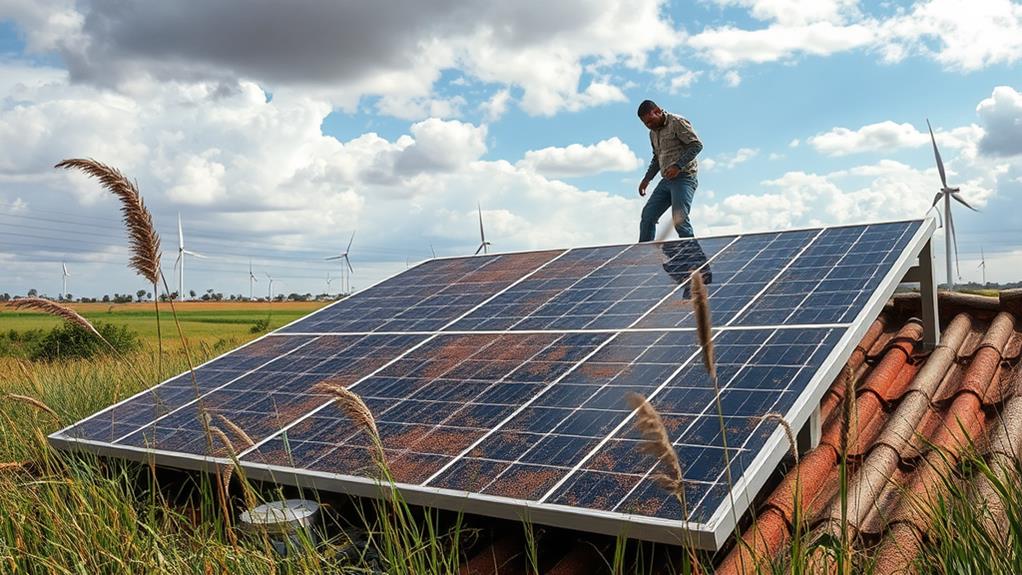Imagine your solar panels as soldiers standing guard on the rooftops of Kenya, facing the relentless charge of wind gusts in the Rift Valley and northeastern regions. These winds, sometimes exceeding 60 km/h, can be formidable adversaries, potentially causing delamination or cracked glass. To protect your investment, you must choose durable materials and employ aerodynamic mounting systems. But, how exactly do these strategies play out in real-world conditions, and what maintenance practices can guarantee your panels withstand these challenges? Let's explore the nuanced relationship between wind patterns and solar panel durability in Kenya.
Wind Patterns in Kenya

Understanding wind patterns in Kenya is essential for evaluating the potential damage to solar panels. You need to grasp how regional variations in wind speeds and directions affect solar installations.
Kenya's diverse topography creates significant climate impact differences across regions. For instance, coastal areas like Mombasa experience trade winds averaging 20 km/h, while the Rift Valley has higher wind speeds, often exceeding 30 km/h due to its unique topographic funneling effects.
Additionally, modern solar panels are built with tempered glass and corrosion-resistant frames to endure harsh weather conditions.
Data from the Kenya Meteorological Department reveals that the northeastern regions, influenced by the Somali Jet, can face gusts up to 40 km/h, posing a higher risk to solar panel structures. By comparing these regional variations, you can better assess the engineering requirements for solar panel mounts and supports.
Incorporating wind load calculations based on empirical data is essential for minimizing potential damage. Wind pressure on solar panels is directly proportional to the square of the wind speed, making accurate data indispensable.
Understanding these patterns enables you to design installations that withstand Kenya's specific climatic conditions, ensuring longevity and efficiency. Remember, the goal is to harness the sun's power without compromising on structural integrity, allowing for both energy freedom and resilience.
Types of Solar Panels
Selecting the right types of solar panels is essential for optimizing performance and durability under Kenya's varying wind conditions.
Monocrystalline panels, known for their high-efficiency rates and longevity, are crafted from a single continuous crystal structure. This type of panel boasts efficiencies often exceeding 20%, making them ideal if you're aiming to maximize energy output per square meter. Their uniform look and higher power capacity are notable advantages, especially in areas where space is at a premium. Additionally, they contribute to reduced carbon footprint by providing sustainable energy solutions.
Polycrystalline panels, on the other hand, are made from silicon crystals melted together. While their efficiency ranges between 15-17%, they're more cost-effective, offering a viable alternative if you're looking to balance cost and performance. These panels tend to have a bluish hue and are slightly less efficient in high-temperature environments, a factor to take into account given Kenya's climate.
Selecting between monocrystalline and polycrystalline panels involves a trade-off between efficiency and cost. Monocrystalline panels offer superior efficiency and durability, vital for withstanding wind loads.
Polycrystalline panels, while less efficient, provide a more affordable option without greatly compromising on performance. Each type has its merits, but your choice should align with your specific energy needs and budget constraints while evaluating local wind patterns.
Wind-Induced Damage

Wind-Induced Damage
Wind-induced damage presents a significant challenge to maintaining the longevity and efficiency of solar panels in Kenya. You need to understand the technicalities behind this to make informed decisions.
Wind resistance is vital, as Kenyan regions often experience high wind speeds. Panels lacking proper wind resistance are prone to mechanical failures, leading to compromised energy output and expensive repairs. Additionally, understanding solar energy benefits like cost savings and energy independence can help justify the investment in durable panels.
Panel durability is another key factor. If panels aren't built to withstand the dynamic stresses of high winds, they can suffer from delamination, cracked glass, and loosened mounts. This not only reduces the panel's efficiency but also its overall lifespan.
Here's what you should consider:
- Wind Load Ratings: Verify your solar panels meet or exceed local wind load ratings to withstand extreme conditions.
- Mounting Systems: Opt for robust mounting systems that enhance the wind resistance of your panels.
- Regular Inspections: Schedule regular inspections to catch and fix wind-induced wear and tear early.
Incorporating these considerations will help you maximize the operational lifespan and efficiency of your solar panel installation.
Structural Solutions
To effectively mitigate wind-induced damage to solar panels, employing well-engineered structural solutions is crucial. You need to focus on engineering innovations that enhance the resilience of solar panel installations.
One critical technique involves utilizing aerodynamic mounting systems. These systems minimize wind uplift by streamlining the airflow over and around the panels, reducing the risk of detachment.
Another effective innovation is the use of reinforced framing materials. High-tensile aluminum or galvanized steel frames provide superior structural integrity, capable of withstanding high wind loads.
Additionally, anchoring systems must be robust. Ground-mounted panels benefit from deep-set concrete footings, while roof-mounted solutions require secure, wind-resistant brackets and fasteners.
Installation techniques also play a pivotal role. Ideal panel orientation and spacing can considerably reduce wind pressure. Panels should be installed at an angle that deflects wind forces rather than absorbing them.
Furthermore, spacing between rows needs to be calculated precisely to avoid wind tunnel effects that amplify pressure.
Data from wind load assessments and computational fluid dynamics (CFD) simulations will guide these structural choices. By integrating these advanced methodologies, you can ascertain that your solar installations are both efficient and fortified against Kenya's challenging wind conditions.
Maintenance Practices

Effective maintenance practices are vital for guaranteeing the longevity and efficiency of solar panel installations in windy regions like Kenya. You need to follow a structured approach to prevent damage and maintain peak performance. Regular inspections for physical wear, especially after windstorms, are essential.
You should also adhere to strict installation guidelines to guarantee panels are securely mounted, minimizing the risk of displacement. Additionally, solar-powered devices like water heaters and outdoor lights can also benefit from consistent upkeep to promote sustainability.
Proper cleaning techniques can't be overstated. Dust and debris accumulation can markedly reduce energy output. Utilize anti-static treatments and soft-bristle brushes to avoid scratching the panels, which could compromise their efficiency and structural integrity. Always check for micro-cracks, as these can worsen under high wind conditions.
Here are some key maintenance practices:
- Regular Cleaning: Use deionized water and soft brushes to prevent scratching.
- Routine Inspections: Look for loose mounts and micro-cracks, especially after storms.
- Adherence to Guidelines: Follow manufacturer installation guidelines to the letter.
Case Studies and Data
Case studies and data provide invaluable insights into the resilience of solar panels under windy conditions in Kenya. By examining real-world installations, you'll gain an in-depth understanding of how different systems withstand high wind speeds.
One case study, conducted in the Turkana region, revealed that panels secured with galvanized steel frames showed a 30% increase in structural integrity compared to those using aluminum supports. Technical support teams often recommend such durable materials for installations in high-wind areas to enhance reliability.
Damage assessment data from the Marsabit area indicated that panels mounted at a 15-degree tilt angle experienced less stress and fewer micro-cracks than those at steeper angles. This performance analysis highlights the importance of ideal installation techniques to enhance durability.
In another resilience evaluation, data from Nairobi's urban environment showed that panels with dual-axis tracking systems were more susceptible to wind-induced mechanical failures. Notably, panels featuring reinforced glass and flexible mounting solutions demonstrated significant resistance to wind loads exceeding 60 km/h.
These case studies and data-driven insights empower you to make informed decisions about solar installations in windy regions. By understanding the nuanced effects of wind on different setups, you can optimize your systems for maximum efficiency and longevity, thereby enjoying the freedom of sustainable energy without compromising on performance.
Conclusion
To wrap it up, while wind can be a bit of a nuisance for solar panels in Kenya, especially in high-speed areas, you can mitigate these issues. Using robust materials, aerodynamic mounts, and guaranteeing proper installation techniques will greatly reduce the risk of damage. Regular maintenance and inspections are also essential. By taking these measures, you'll ensure your solar energy systems remain efficient and long-lasting, even in Kenya's challenging wind conditions.
